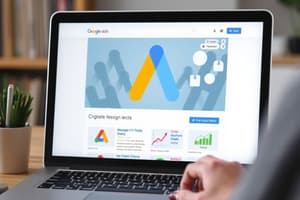Podcast
Questions and Answers
Which strategy is essential for launching a high-tech product to maintain momentum in purchasing?
Which strategy is essential for launching a high-tech product to maintain momentum in purchasing?
- Releasing the product with a quick scheduling (correct)
- Utilizing slow-paced marketing
- Offering extensive tutorials before launch
- Focusing solely on technical specifications
What should be clearly defined at the launch of a product?
What should be clearly defined at the launch of a product?
- The product's price only
- The technical support plan
- Goals expected to be achieved (correct)
- Advertising budget
Which of the following is a key lesson learned from the Google Glass failure?
Which of the following is a key lesson learned from the Google Glass failure?
- Ensure the benefits are prominently highlighted (correct)
- Neglect consumer requirements
- Focus only on product creativity
- Limit the use of paid media
What is important to do with product advertising after a launch?
What is important to do with product advertising after a launch?
What overarching issue contributed to the failure of Google Glass?
What overarching issue contributed to the failure of Google Glass?
What significant health concern was associated with Google Glass?
What significant health concern was associated with Google Glass?
Why did Google Glass face rejection from mass-market consumers?
Why did Google Glass face rejection from mass-market consumers?
What marketing issue contributed to the failure of Google Glass?
What marketing issue contributed to the failure of Google Glass?
Which technological aspect of Google Glass raised privacy concerns?
Which technological aspect of Google Glass raised privacy concerns?
What was one major criticism regarding the functionality of Google Glass?
What was one major criticism regarding the functionality of Google Glass?
How did Google attempt to position Google Glass before its launch?
How did Google attempt to position Google Glass before its launch?
What was a significant aspect of the criticism faced by Google Glass aside from health concerns?
What was a significant aspect of the criticism faced by Google Glass aside from health concerns?
Which of the following statements accurately reflects public sentiment towards Google Glass?
Which of the following statements accurately reflects public sentiment towards Google Glass?
What was one of the main reasons Google Glass was considered impractical for users?
What was one of the main reasons Google Glass was considered impractical for users?
What was a significant issue related to the battery of Google Glass?
What was a significant issue related to the battery of Google Glass?
Despite its drawbacks, how was Google Glass priced?
Despite its drawbacks, how was Google Glass priced?
In which language did Google Glass operate most effectively?
In which language did Google Glass operate most effectively?
What issue arose after recording video on Google Glass for a prolonged period?
What issue arose after recording video on Google Glass for a prolonged period?
Which specification was notably lacking in the Google Glass?
Which specification was notably lacking in the Google Glass?
What was one of the main consumer complaints about the Google Glass?
What was one of the main consumer complaints about the Google Glass?
Which of the following was NOT a primary concern regarding the Google Glass?
Which of the following was NOT a primary concern regarding the Google Glass?
Flashcards
Google Glass
Google Glass
A wearable technology developed by Google, marketed as a revolutionary device.
Consumer Needs
Consumer Needs
Features and usability required by everyday users.
Product Viability
Product Viability
The ability of a product to succeed in the marketplace.
Health Concerns
Health Concerns
Signup and view all the flashcards
Limited Functionality
Limited Functionality
Signup and view all the flashcards
Privacy Concerns
Privacy Concerns
Signup and view all the flashcards
Battery Life
Battery Life
Signup and view all the flashcards
High Price Point
High Price Point
Signup and view all the flashcards
Language Limitation
Language Limitation
Signup and view all the flashcards
Overheating Problems
Overheating Problems
Signup and view all the flashcards
Marketing Lessons
Marketing Lessons
Signup and view all the flashcards
Effective PR
Effective PR
Signup and view all the flashcards
Timed Releases
Timed Releases
Signup and view all the flashcards
Consumer Feedback
Consumer Feedback
Signup and view all the flashcards
Marketing Strategy
Marketing Strategy
Signup and view all the flashcards
Product Performance
Product Performance
Signup and view all the flashcards
Limited Functions
Limited Functions
Signup and view all the flashcards
Moonshot Technology
Moonshot Technology
Signup and view all the flashcards
Clear Functionality
Clear Functionality
Signup and view all the flashcards
Product Alignment
Product Alignment
Signup and view all the flashcards
Study Notes
Google Glass Overview
- Google Glass was marketed as a revolutionary wearable technology by Google, branded as "moonshot" technology.
- Despite high expectations and advanced technology, Google Glass failed to resonate with consumers.
Reasons for Failure
-
Health and Safety Concerns
- Concerns arose about potential carcinogenic radiation emitted near the brain and eyes.
- Issues regarding privacy, as the device could capture images without others' consent.
-
Lack of Clear Functionality
- Google Glass had limited functions: quick photo capture and internet searching.
- The absence of practical applications reduced its appeal to consumers.
-
Battery Limitations
- Featured a fixed battery life of only 4 hours, leading to frequent charging needs.
- Unpredictable discharging made the device less reliable during use.
-
High Price Point
- Launched at approximately $1,500, the high cost deterred potential buyers.
- Issues with functionality and usability could not justify the price tag.
-
Language Limitations
- Functionality was primarily limited to American and British English, making it inaccessible for non-native speakers.
- Lack of keyboard input further complicated usability in different languages.
-
Heating Issues
- Prolonged usage, such as recording videos, led to overheating problems.
- Excessive heat generated during use posed potential health risks.
Marketing Lessons from Google Glass
- Highlight everyday benefits prominently through effective media and PR strategies.
- Release products in a timed manner to capitalize on consumer interest and momentum.
- Avoid repeating the mistakes encountered with Google Glass in future product launches.
- Clearly communicate the goals and functionalities of the product before launch.
- Continuously monitor and adjust marketing strategies based on consumer feedback and product performance.
Conclusion
- Google Glass showcased significant potential in creativity and technology but failed due to critical oversights in consumer needs and product viability.
- Future technologies must ensure alignment with consumer requirements amidst rapid technological advancements.
Studying That Suits You
Use AI to generate personalized quizzes and flashcards to suit your learning preferences.




